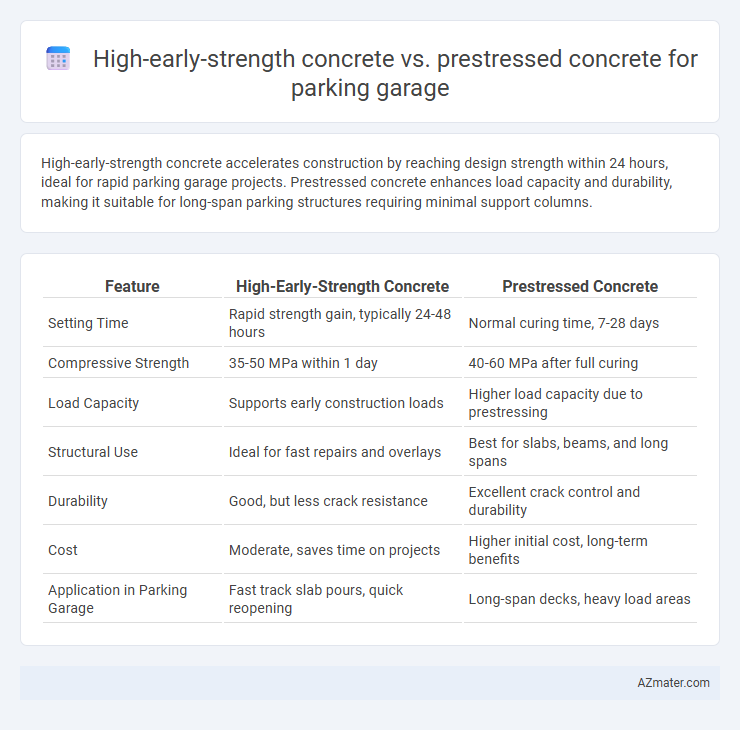High-early-strength concrete accelerates construction by reaching design strength within 24 hours, ideal for rapid parking garage projects. Prestressed concrete enhances load capacity and durability, making it suitable for long-span parking structures requiring minimal support columns.
Table of Comparison
| Feature | High-Early-Strength Concrete | Prestressed Concrete |
|---|---|---|
| Setting Time | Rapid strength gain, typically 24-48 hours | Normal curing time, 7-28 days |
| Compressive Strength | 35-50 MPa within 1 day | 40-60 MPa after full curing |
| Load Capacity | Supports early construction loads | Higher load capacity due to prestressing |
| Structural Use | Ideal for fast repairs and overlays | Best for slabs, beams, and long spans |
| Durability | Good, but less crack resistance | Excellent crack control and durability |
| Cost | Moderate, saves time on projects | Higher initial cost, long-term benefits |
| Application in Parking Garage | Fast track slab pours, quick reopening | Long-span decks, heavy load areas |
Introduction to Parking Garage Concrete Solutions
High-early-strength concrete allows parking garages to achieve rapid load capacity and reduced construction time, essential for fast-paced project schedules. Prestressed concrete provides superior structural performance and durability by counteracting tensile stresses, enhancing load-bearing capacity for multi-level parking structures. Both solutions optimize parking garage design for longevity and efficiency, with selection depending on project-specific requirements.
Overview of High-Early-Strength Concrete
High-early-strength concrete gains compressive strength rapidly, typically achieving 6,000 psi within 24 hours, making it ideal for fast-track parking garage construction requiring early load application. Its accelerated curing reduces formwork cycles and minimizes downtime compared to traditional mixes, enhancing project efficiency. Unlike prestressed concrete, which relies on tensioned reinforcement to resist loads, high-early-strength concrete primarily benefits from its rapid strength development, allowing quicker structural turnover.
Overview of Prestressed Concrete
Prestressed concrete in parking garages offers enhanced load-bearing capacity and improved durability compared to high-early-strength concrete by introducing internal stresses to counteract tensile forces. This method reduces cracking and deflection, enabling longer spans and fewer columns, which maximizes usable parking space. Its cost-effectiveness over time and superior performance under dynamic loads make it a preferred choice for multi-level parking structures.
Key Performance Criteria for Parking Garages
High-early-strength concrete accelerates construction timelines by achieving rapid curing and early load-bearing capacity, essential for timely parking garage projects. Prestressed concrete enhances structural performance through pre-compression, reducing serviceability issues such as cracking and deflection under heavy vehicle loads. Both materials improve durability and longevity, but prestressed concrete offers superior resistance to fatigue and dynamic loads common in multi-level parking facilities.
Structural Strength Comparison: High-Early-Strength vs Prestressed
High-early-strength concrete achieves compressive strengths of up to 6,000 psi within 24 hours, making it ideal for rapid construction schedules in parking garages. Prestressed concrete, however, provides superior tensile strength by inducing compressive stresses through tensioned steel tendons, enabling longer spans and reduced cracking. Structurally, prestressed concrete offers enhanced load-bearing capacity and durability compared to high-early-strength concrete, which primarily excels in early strength gain but may require additional reinforcement for tensile performance.
Construction Timeline and Project Acceleration
High-early-strength concrete significantly reduces curing time, enabling earlier formwork removal and accelerated construction of parking garage decks compared to conventional mixes. Prestressed concrete allows for longer spans and thinner slabs, minimizing the number of columns and speeding up erection by reducing repetitive supports. Utilizing high-early-strength or prestressed concrete can shorten project timelines by enabling faster load application and reducing the overall construction schedule.
Durability and Longevity in Parking Structures
High-early-strength concrete offers rapid curing and sufficient early load-bearing capacity, which is advantageous for fast-track parking garage projects but may experience microcracking under sustained heavy loads, impacting durability. Prestressed concrete incorporates tensioned steel tendons that enhance structural integrity by minimizing cracks and deflections, significantly extending the longevity and service life of parking structures subjected to continuous vehicle loads and environmental exposure. The superior crack control and load distribution in prestressed concrete typically result in reduced maintenance costs and improved durability compared to high-early-strength concrete in parking garage applications.
Cost Implications and Budget Analysis
High-early-strength concrete reduces construction time for parking garages by achieving required strength faster, lowering labor and equipment rental costs, which can significantly cut overall project expenses. Prestressed concrete offers enhanced durability and load-bearing capacity, potentially reducing maintenance costs over the garage's lifespan but involves higher initial material and fabrication costs due to specialized prestressing tendons and processes. Budget analysis indicates choosing high-early-strength concrete favors accelerated schedules and immediate cost savings, while prestressed concrete demands higher upfront investment but can yield long-term economic benefits through reduced repairs and extended service life.
Sustainability and Environmental Considerations
High-early-strength concrete enables rapid construction of parking garages, reducing onsite labor and energy consumption, which lowers the carbon footprint associated with prolonged building phases. Prestressed concrete offers enhanced durability and reduced material usage by optimizing load-bearing capacity, resulting in less cement demand and decreased CO2 emissions over the structure's lifecycle. Employing either material supports sustainable construction by improving longevity and minimizing environmental impact through efficient resource utilization and reduced maintenance needs.
Choosing the Right Concrete Solution for Parking Garages
High-early-strength concrete accelerates construction timelines by achieving rapid load-bearing capacity, making it ideal for fast-paced parking garage projects requiring early use. Prestressed concrete provides superior durability and load distribution through tensioned reinforcement, enhancing structural performance against heavy vehicular loads and long-span designs. Selecting between these depends on project priorities such as time constraints, structural demands, and lifecycle cost efficiency for optimal parking garage performance.

Infographic: High-early-strength concrete vs Prestressed concrete for Parking garage
 azmater.com
azmater.com